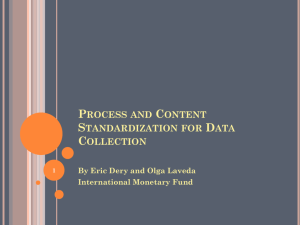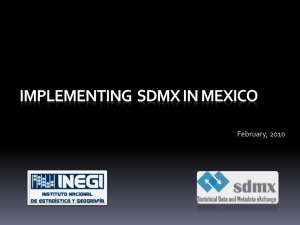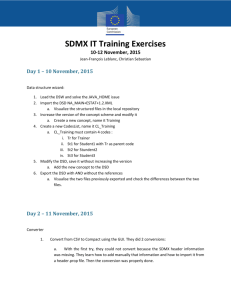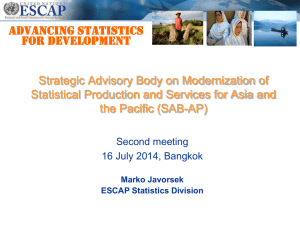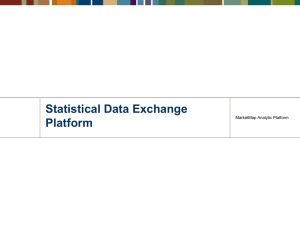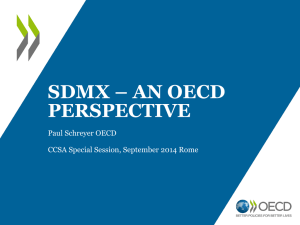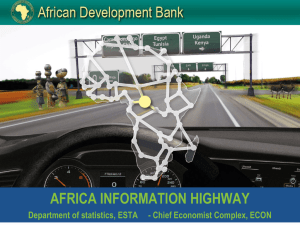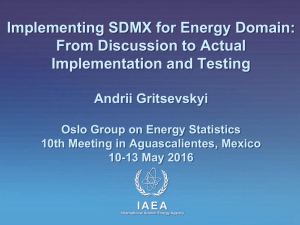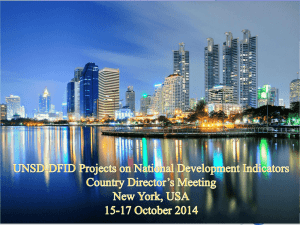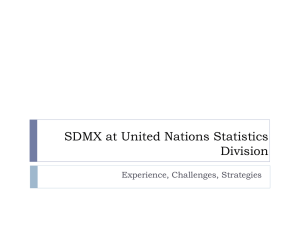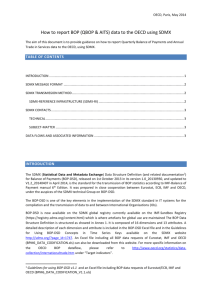Second MSIS Meeting for International Organizations (Paris, France
advertisement
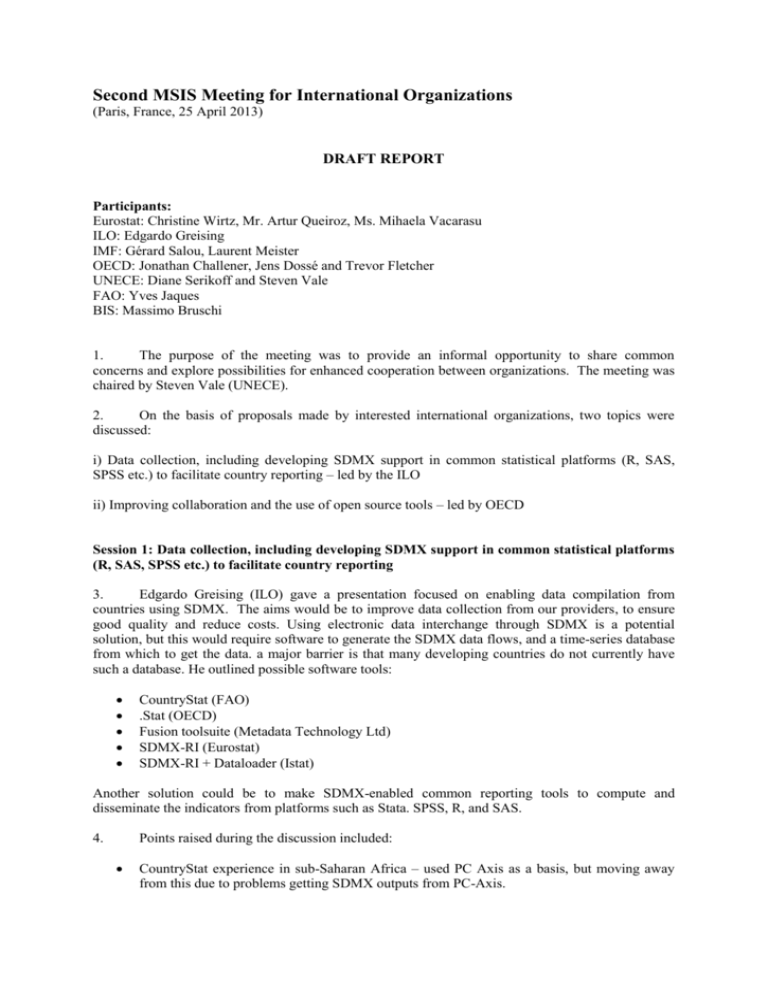
Second MSIS Meeting for International Organizations (Paris, France, 25 April 2013) DRAFT REPORT Participants: Eurostat: Christine Wirtz, Mr. Artur Queiroz, Ms. Mihaela Vacarasu ILO: Edgardo Greising IMF: Gérard Salou, Laurent Meister OECD: Jonathan Challener, Jens Dossé and Trevor Fletcher UNECE: Diane Serikoff and Steven Vale FAO: Yves Jaques BIS: Massimo Bruschi 1. The purpose of the meeting was to provide an informal opportunity to share common concerns and explore possibilities for enhanced cooperation between organizations. The meeting was chaired by Steven Vale (UNECE). 2. On the basis of proposals made by interested international organizations, two topics were discussed: i) Data collection, including developing SDMX support in common statistical platforms (R, SAS, SPSS etc.) to facilitate country reporting – led by the ILO ii) Improving collaboration and the use of open source tools – led by OECD Session 1: Data collection, including developing SDMX support in common statistical platforms (R, SAS, SPSS etc.) to facilitate country reporting 3. Edgardo Greising (ILO) gave a presentation focused on enabling data compilation from countries using SDMX. The aims would be to improve data collection from our providers, to ensure good quality and reduce costs. Using electronic data interchange through SDMX is a potential solution, but this would require software to generate the SDMX data flows, and a time-series database from which to get the data. a major barrier is that many developing countries do not currently have such a database. He outlined possible software tools: CountryStat (FAO) .Stat (OECD) Fusion toolsuite (Metadata Technology Ltd) SDMX-RI (Eurostat) SDMX-RI + Dataloader (Istat) Another solution could be to make SDMX-enabled common reporting tools to compute and disseminate the indicators from platforms such as Stata. SPSS, R, and SAS. 4. Points raised during the discussion included: CountryStat experience in sub-Saharan Africa – used PC Axis as a basis, but moving away from this due to problems getting SDMX outputs from PC-Axis. Some countries want to run their own servers, but there is increasing interest in cloud computing and remote hosting, which remove the burden of running hardware and software. Few developing countries use SDMX, or have the capacity to create it. DevInfo has software that has an SDMX output aimed at developing countries, but it is focused on Millennium Development Goal data. The African Development Bank has an initiative to develop a dissemination platform within the next one or two years. The IMF would like to have more machine to machine data collection. Within the European Statistical System, countries have their own database infrastructures. Some countries that are not able to produce SDMX use Excel instead. An Excel to SDMX convertor would be very useful for them. Getting agreement on the data structure definitions (DSDs) can be much more difficult than resolving the technical issues for more developed countries, but technology remains a major issue for many less-developed countries, where even having a reliable electricity supply can be a problem. IMF is moving towards a range of collection options, including SDMX and Excel, to facilitate data supply from countries. Perhaps different data collection tools could be seen as complementary in a “plug and play” sense? 5. In summary, participants agreed that the table presented by the ILO was useful, and should be verified and extended by all participants, via the UNECE Wiki. It would also be useful to present the revised table to the SDMX Sponsors. Next steps could include developing a gap analysis and user scenarios. Session 2: Improving collaboration and the use of open source tools 6. Trevor Fletcher (OECD) introduced this topic by observing that collaboration is on the increase, mainly driven by the activities of the High-Level Group and subsidiary groups such as MSIS and the Sharing Advisory Board. Further evidence is that the recent Statistical Information Systems Collaboration Community Workshop attracted 50 participants from 21 organizations. Whilst collaboration is clearly a good thing, it raises various challenges, including governance and aligning priorities between organisations. To be effective, collaboration should be based on common standards. He asked participants to outline their experiences and plans concerning collaboration. 7. Points raised during the discussion included: ILO plans to use the SDMX Data Mapper, and is implementing an SDMX interface. Microdata software from the World Bank looks interesting, with metadata in DDI format. FAO has developed a glossary tool based on open source software, extended with plug-ins to add functionality. This could be seen as a different architectural model to “plug and play”. IMF has started inserting a clause in contracts with software developers to allow sharing of the outputs. Gerard will share the wording of such clauses with the group. The IMF also shares econometric models with other organisations. Eurostat plans to release the source code of Demetra+, Tau-Argus and several SDMX tools as open source. Mexico has expressed interest in the EDAMIS data collection application, but this was not originally designed to be sharable. OECD share the .stat applications with several other organisations, and is starting to see benefits from leveraging the capacity for further development in the wider community. Software is not the main business, so a partnership model is preferable to a supplier / customer relationship. UNECE collaboration activities are facilitated by a wiki platform. Open source and free components are used in the data management system. BIS has sponsored the development of some SDMX tools, which have been made available as open source. Common user groups for commercial tools (e.g. Prognoz applications) could give international organisations more bargaining power. 8. In summary, participants agreed that all collaboration efforts should be seen as good. Framework tools such as an inventory of who is doing what, and which resources are available for sharing, would be useful. The software inventory and “Key indicators” on the MSIS Wiki could be a good starting point. Summary and next steps 9. The chair summarized the meeting, drawing the main points from each discussion. All documents for the meeting will be made public on the MSIS wiki.
